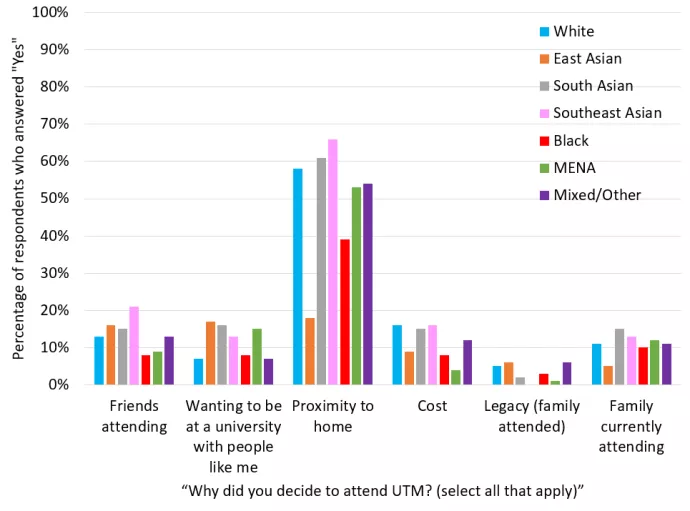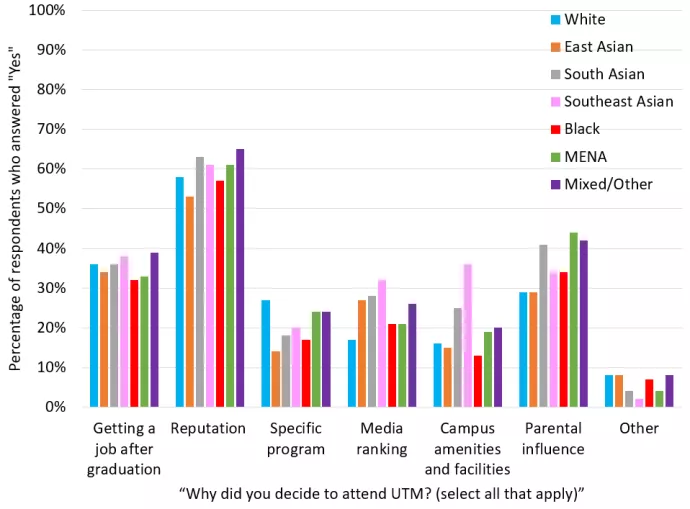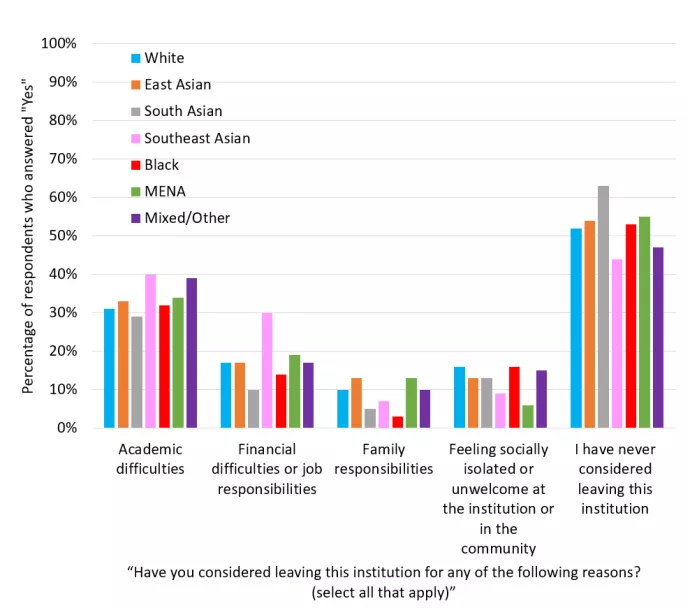In Fall 2018 and Winter 2019, the Peel Social Lab surveyed approximately 1,236 students enrolled in our Introduction to Sociology course (SOC100H5) for insight on UTM students, especially their experiences with multiculturalism and disability (primarily on campus), perceptions of resistance, and motivations for pursuing particular institutions and fields of study.
- View codebook
- Download Excel (.xlsx) data file
- Download Stata (.dta) data file
- Data Highlights
- Figures
Data Highlights
- Demographics of respondents and their caregivers
- 31% of students surveyed were currently working for pay, with 21% of working respondents working 20 or more hours a week
- Students surveyed were most likely to identify as women (67%), foreign-born (54%), and South Asian (28%)
- 4% of respondents reported having a disability
- Most respondents lived in Mississauga (61%), and 71% of those in Mississauga lived off campus
- When asked about their caregivers, 86% of the first two caregivers respondents listed were foreign-born, and 39-42% of them had at least a Bachelors degree (or equivalent)
- Health and wellbeing
- 78% of respondents rated their health as at least “good”, but much less (although still a majority) rated their mental health as at least “good” (61%)
- At least 30% reported often feeling “helpless” dealing with life problems or “pushed around in life”
- Academic Background and Career Plans
- Respondents were most likely to report interest in working in the fields of medicine (25%), science/technology (25%), and business (23%)
- 17% report that they plan to start their own business
- Choice, focus, and outcomes
- 60% of respondents reported choosing to attend UTM due to its reputation, and 36% believed it would get them a job after graduation
- 48% selected the university due to its proximity to home, and 36% were influenced by parental opinion
- 64% of students reported that they believed their UTM degree would be important to getting a job after graduation due to the school’s or program’s reputation, while only 27% believed it would be because of the skills and knowledge they gain at the institution
- 34% of students surveyed were majoring in or planning to major in the social sciences, commerce, or manage; 53% in the chemical, physical, forensics, computer, mathematical, statistical, and psychological sciences; and 30% in the humanities, communication, culture, information technology, and visual studies
- 31% of respondents did not know yet what their major would be
Figures
Figure 1. Percentage of students who selected various reasons for attending UTM (Part 1)

|
|
Friends attending (%) |
Wanting to be at a university with people like me (%) |
Proximity to home (%) |
Cost (%) |
Legacy (family attended) (%) |
Family currently attending (%) |
|---|---|---|---|---|---|---|
|
White |
13 |
7 |
58 |
16 |
5 |
11 |
|
East Asian |
16 |
17 |
18 |
9 |
6 |
5 |
|
South Asian |
15 |
16 |
61 |
15 |
2 |
15 |
|
Southeast Asian |
21 |
13 |
66 |
16 |
0 |
13 |
|
Black |
8 |
8 |
39 |
8 |
3 |
10 |
|
Middle Eastern, North African |
9 |
15 |
53 |
4 |
1 |
12 |
|
Mixed / Other |
13 |
7 |
54 |
12 |
6 |
11 |
Figure 1 is a clustered column chart. It presents part 1 of responses to the question “Why did you decide to attend UTM?”, as noted in the title of the horizontal axis. Respondents could select multiple answers. The horizonal axis presents six answers (Figure 2 presents the remaining seven options): 1) friends attending; 2) wanting to be at a university with “people like me”; 3) proximity to home; 4) cost; 5) legacy (family attended); 6) family currently attending. The vertical axis shows percentages from 0% to 100%. The legend shows that the results are divided into seven self-reported racial/ethnic categories, each with a differently coloured column: 1) White (blue columns); 2) East Asian (orange); 3) South Asian (grey); 4) Southeast Asian (pink); 5) Black (red); 6) Middle Eastern or North African (green); 7) Mixed race or other (purple). The columns represent the percentage of respondents in each category who responded “Yes” to any of those answers. Therefore, the six sets of columns represent six different variables, and totaling the different answers may not add up to 100%. The table below the chart presents the same information.
Figure 2. Percentage of students who selected various reasons for attending UTM (Part 2)

|
|
Getting a job after graduation (%) |
School’s reputation (%) |
Specific program (%) |
School’s media ranking (%) |
Campus amenities and facilities (%) |
Parental influence (%) |
Other (%) |
|---|---|---|---|---|---|---|---|
|
White |
36 |
58 |
27 |
17 |
16 |
29 |
8 |
|
East Asian |
34 |
53 |
14 |
27 |
15 |
29 |
8 |
|
South Asian |
36 |
63 |
18 |
28 |
25 |
41 |
4 |
|
Southeast Asian |
38 |
61 |
20 |
32 |
36 |
34 |
2 |
|
Black |
32 |
57 |
17 |
21 |
13 |
34 |
7 |
|
Middle Eastern, North African |
33 |
61 |
24 |
21 |
19 |
44 |
4 |
|
Mixed / Other |
39 |
65 |
24 |
26 |
20 |
42 |
8 |
Figure 2 is a clustered column chart. It presents part 2 of responses to the question “Why did you decide to attend UTM?”, as noted in the title of the horizontal axis. Respondents could select multiple answers. The horizonal axis presents seven answers: 1) getting a job after graduation; 2) the school’s reputation; 3) a specific program; 4) the school’s media ranking; 5) campus amenities and facilities; 6) parental influence; 7) other reason. The vertical axis shows percentages from 0% to 100%. The legend shows that the results are divided into seven self-reported racial/ethnic categories, each with a differently coloured column: 1) White (blue columns); 2) East Asian (orange); 3) South Asian (grey); 4) Southeast Asian (pink); 5) Black (red); 6) Middle Eastern or North African (green); 7) Mixed race or other (purple). The columns represent the percentage of respondents in each category who responded “Yes” to any of those answers. Therefore, the seven sets of columns represent seven different variables, and totaling the different answers may not add up to 100%. The table below the chart presents the same information.
Figure 3. Percentage of different racial or ethnic groups who have considered leaving UTM for certain reasons, or not at all

|
|
Academic difficulties (%) |
Financial difficulties or job responsibilities (%) |
Family responsibilities (%) |
Feeling socially isolated or unwelcome at the institution or in the community (%) |
I have never considered leaving this institution (%) |
|---|---|---|---|---|---|
|
White |
31 |
17 |
10 |
16 |
52 |
|
East Asian |
33 |
17 |
13 |
13 |
54 |
|
South Asian |
29 |
10 |
5 |
13 |
63 |
|
Southeast Asian |
40 |
30 |
7 |
9 |
44 |
|
Black |
32 |
14 |
3 |
16 |
53 |
|
Middle Eastern, North African |
34 |
19 |
13 |
6 |
55 |
|
Mixed / Other |
39 |
17 |
10 |
15 |
47 |
Figure 3 is a clustered column chart. It presents responses to the question “Have you considered leaving this institution for any of the following reasons?”, as noted in the title of the horizontal axis. Respondents could select multiple answers. The horizonal axis presents five answers: 1) academic difficulties, 2) financial difficulties or job responsibilities, 3) family responsibilities, 4) feeling socially isolated or unwelcome at the institution or in the community, and 5) “I have never considered leaving this institution”. The vertical axis shows percentages from 0% to 100%. The legend shows that the results are divided into seven self-reported racial/ethnic categories, each with a differently coloured column: 1) White (blue columns); 2) East Asian (orange); 3) South Asian (grey); 4) Southeast Asian (pink); 5) Black (red); 6) Middle Eastern or North African (green); 7) Mixed race or other (purple). The columns represent the percentage of respondents in each category who responded “Yes” to any of those answers. Therefore, the five sets of columns represent five different variables, and totaling the different answers may not add up to 100%. The table below the chart presents the same information.
